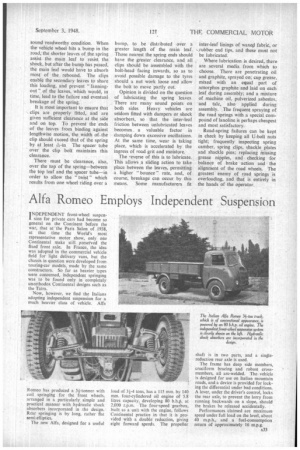Alfa Romeo Employs Independent Suspension
Page 51

If you've noticed an error in this article please click here to report it so we can fix it.
INDEPEN DENT front-wheel suspension for private cars had become so general on the Continent before the war, that at-the Paris Salon of 1938, at that time the World's most representative motor show, only one Continental make still preserved the fixed front axle. In France, the idea was adopted in the commercial vehicle field for light delivery vans, but the chassis in question were developed from touring-car models, made by the same constructors. So far as heavier types were concerned, independent springing was to be found only in completely unorthodox Continental designs such as the Tatra.
Now, however, we find the Italians adopting independent suspension for a much heavier class of vehicle. Alfa Romeo has produced a 31-tonner with coil springing for the front wheels, arranged in a particularly simple and practical manner with hydraulic shock absorbers incorporated in the design. Rear springing is by long, rather flat semi-elliptics.
The new Alfa, designed for a useful load of 31-4 tons, has a 115 mm. by 140 mm. four-cylindered oil engine of 5.8 litres capacity, developing 80 b.h.15. at 2,000 r.p.m. The four-speed gearbox, built as a unit with the engine, follows Continental practice in that it is provided with a double reduction, giving eight forward speeds. The propeller shaft is in two parts, and a singlereduction rear axle is used.
The frame has deep side members, cruciform bracing and robust crossmembers, all arc-welded. The vehicle is designed for use on Italian mountain roads, and a device is provided for locking the differential under bad conditions. A lever, under the driver's control, locks the rear axle, to prevent the lorry from running backwards on a slope, should the brakes be released accidentally.
Performances claimed are maximum speed under full load on the level, about 40 m.p.h., and a fuel-consumption return of approximately 16 m.p.g.




















































































